Complete Solutions to All Questions of chapter DATA HANDLING-III (BAR GRAPHS) of Class 6 book with complete answers and questions
| Class 6 | MATHS |
| Chapter | DATA HANDLING-III (BAR GRAPHS) |
| Mathematics | All Questions |
| Number Of Questions | 35 |
| Academic Year | 2023-24 |
Following table shows the number of bicycles manufactured in a factory during the years 1998 to 2002. Illustrate this data using a bar graph. Choose a scale of your choice
03:18View SolutionThe following table gives the number of vehicles passing through a busy crossing in Delhi in different time intervals on a particular day. Time interval, 8-9 hrs, 9-10 hrs, 10-11 hrs, 11-12 hrs, 12-13 hrs, 13-14 hrs, 14-15 hrs, 15-16 hrs, 16-17 hrs, 17-18 hrs No. of Vehicles, 300, 400, 350, 250, 200, 150, 100, 200, 300, 450 Represent the above data by a bar graph.
04:07View SolutionRead the bar graph shown in Figure and answer the following questions: What is the information given by the bar graph? What are the different numbers of the shoe-worn by the students? What is the number of students wearing shoe No. 6? Which shoe number is worn by the maximum number of students? Also give its number. Which shoe number is worn by the minimum number of students? Also give its number. State whether true or false. The number of students wearing shoe no.10 is less than three times the number of students wearing shoe no. 9.
03:13View SolutionThe following bar graph shows the number of vehicles passing through a road crossing in Delhi in different time intervals on a particular day. Read the bar graph and answer the following questions: What does the bar graph represent? Also, give the maximum number of vehicles. When is the hourly traffic maximum? Also give the minimum number of vehicles. When is the hourly traffic minimum? What is the total number of vehicles passing through a crossing during a particular day?
03:48View SolutionRead the bar graph shown in Figure and answer the following questions: What is the information given by the bar graph? What is the order of the change of number of students over several years? State whether true or false. The enrolment during 1996-97 is twice that of 1995-96
01:48View SolutionRead the following bar graph shown in Figure and answer the following questions: What is the information given by the bar graph? In which month was the sale of the book maximum? In which month was the sale of the book minimum? What is the total sale of the book during these five months?
04:00View SolutionRead the following bar graph given in Figure and answer the following questions: What information is given by this bar graph? Which two states have same production in 1993-94? Name the state having same production in both the years? Which state has minimum production?
01:48View SolutionThe following table shows the daily production of T.V. sets in an industry for 7 days of a week: Day, Mon, Tue, Wed, Thurs, Fri, Sat, Sun No. of TV Sets, 300, 400, 150, 250, 100, 350, 200 Represent the above information by a pictograph.
03:15View SolutionThe following table shows the number of Maruti cars sold by the five dealers in a particular month: Dealer, Saya, Bagga Links, D.D. Motors, Bhasin Motor, Competent Motors Cars sold, 60, 40, 20, 15, 10 Represent the above information by a pictograph.
03:34View SolutionThe population of Delhi State in different census years is as given below: Census year, 1961, 1971, 1981, 1991, 2001 Population in Lakhs, 30, 55, 70, 110, 150 Represent the above information with the help of a bar graph.
03:56View SolutionRead the bar graph shown in Figure and answer the following questions: What is the information given by the bar graph? How many tickets of Assam State Lottery were sold by the agent? Of which state, were the maximum number of tickets sold? State whether true of false. The maximum number of tickets sold is the three times the minimum number of tickets sold. Of which state were the minimum number of tickets sold?
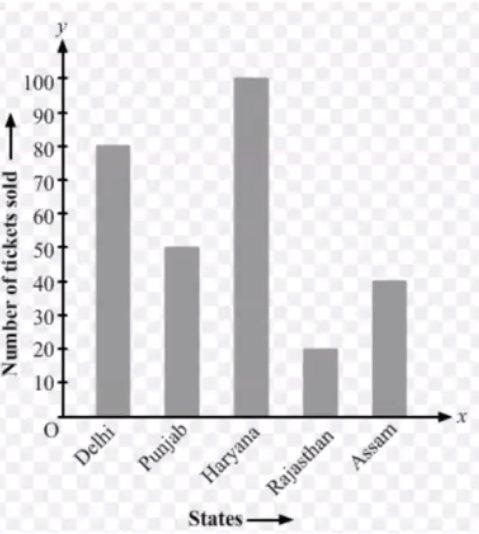 04:33View Solution
04:33View SolutionStudy the bar graph representing the number of persons in various age groups in a town shown in Figure. Observe the bar graph and answer the following questions: What is the percentage of the youngest age-group persons over those in the oldest age group? What is the total population of the town? What is the number of persons in the age group 60-65? How many persons are more in the age-group 10-15 than in the age group 30-35? What is the age-group of exactly 1200 persons living in the town? What is the total number of persons living in the town in the age group 50-55? What is the total number of person living in the town in the age-groups 10-15 and 60-65? Whether the population in general increases, decreases or remains constant with the increase in the age-group.
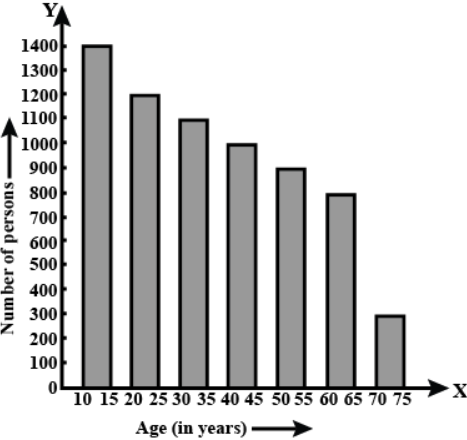 10:07View Solution
10:07View SolutionRead the bar graph shown in Figure and answer the following questions: What is the information given by the bar graph? What was the number of commercial banks in 1977? What is the ratio of the number of commercial banks in 1969 to that in 1980? State whether true or false: The number of commercial banks in 1983 is less than double the number of commercial banks in 1969.
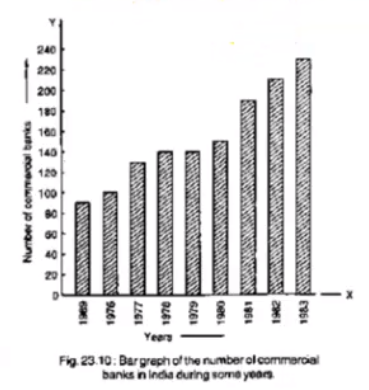 05:38View Solution
05:38View SolutionGiven below Figure in the bar graph indicating the marks obtained out of 50 in mathematics paper by 100 students. Read the bar graph and answer the following questions: It is decided to distribute work books on mathematics to the students obtaining less than 20 marks, giving one workbook to each of such students. If a work book costs Rs. 5, what sum is required to buy the work books? Every student belonging to the highest mark group is entitled to get a prize of Rs. 10. How much amount of money is required for distributing the prize money? Every student belonging to the lowest mark-group has to solve 5 problems per day. How many problems, in all, will be solved by the students of this group per day? State whether true or false. 17% students have obtained marks ranging from 40 to 49. 59% students have obtained marks ranging from 10 to 29. What is the number of students getting less than 20 marks? What is the number of students getting more than 29 marks? What is the number of students getting marks between 9 and 40? What is the number of students belonging to the highest mark group? What is the number of students obtaining more than 19 marks?
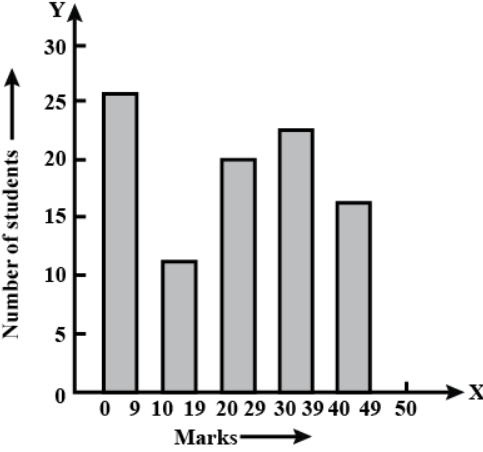 11:10View Solution
11:10View SolutionRead the following bar graph (Figure) and answer the following questions: What is the information given by the bar graph? State each of the following whether true or false. The number of government companies in 1957 is that of 1982 is 1:9. The number of government companies have decreased over the year 1957 to 1983.
01:48View SolutionRead the following bar graph and answer the following questions: What information is given by the bar graph? Which state is the largest producer of rice? Which state is the largest producer of wheat? Which state has total production of rice and wheat as its maximum? Which state has the total production of wheat and rice minimum?
02:38View SolutionThe following bar graph (Figure) represents the heights (in cm) of 50 students of Class XI of a particular school. Study the graph and answer the following questions: What percentage of the total number of students have their heights more than 149 cm? How many students in the class are in the range of maximum height of the class? The school wants to provide a particular type of tonic to each student below the height of 150cm to improve his height. If the cost of the tonic for each student comes out to be Rs. 55, how much amount of money is required? How many students are in the range of shortest height of the class? State whether true or false: There are 9 students in the class whose heights are in the range of 155-159 cm. Maximum height (in cm) of a student in the class is 17. There are 29 students in the class whose heights are in the range of 145-154cm. Minimum height (in cm) of a student is the class is in the range of 140-144cms. The number of students in the class having their heights less than 150cm is 12. There are 14 students each of whom has height more than 154 cm.
05:40View SolutionRead the following bar graph (Figure) and answer the following questions: What information is given by the bar graph? What was the production of cement in the year 1980-81? What is the minimum and maximum productions of cement and corresponding years?
02:17View SolutionThe bar graph shown in Figure represent the circulation of newspapers in 10 languages. Study the bar graph and answer the following questions: What is the total number of newspapers published in Hindi, English, Urdu, Punjabi and Bengali? What percent is the number of news papers published in Hindi of the total number of newspapers? Find the excess of the number of newspapers published in English over those published in Urdu. Name two pairs of languages which publish the same number of newspapers. State the language in which the smallest number of newspapers are published. State the language in which the largest number of newspapers are published. State the language in which the number of newspapers published in between 2500 and 3500. State whether true or false: The number of newspaper published in Malayalam and Marathi together is less than those published in English. The number of newspapers published in Telugu is more than those published in Tamil.
04:38View SolutionThe following data gives the number of students of Delhi state who went abroad for study during some years: year 1995 1996 1997 1998 1999 2000 No. of Students 1400 1600 1250 1000 2000 2200 Represent the above data with the help of a bar graph.
03:50View SolutionIn a school, there are five sections of class VII. The number of students in each section is given below. Construct a bar graph representing this data: Section, A, B, C, D, E No. of Students, 40, 48, 52, 45, 30
03:35View SolutionThe population of four major cities in India in a particular year is given below: City, Mumbai, Kolkata, Delhi, Chennai No. of Students, 120, 130, 150, 80 Construct a bar graph to represent the above data.
03:44View SolutionThe results of pass percentage of Class X and XII in C.B.S.E examination for 5 years are given in the following table: Year, 1994-95, 1995-96, 1996-97, 1997-98, 1998-99 X, 90, 95, 90, 80, 98 XII, 95, 80, 85, 90, 95 Draw bar graphs to represent the data
05:34View SolutionReading and interpretation of bar graphs
03:23View SolutionRead the following bar graph and answer the following question: What information is given by the bar graph? In which year the export is minimum? In which year the import is maximum? In which year the difference of the values of export and import is maximum?
02:18View SolutionThe following bar graph shows the results of an annual examination in a secondary school. Read the bar graph (Figure) and choose the correct alternative in each of the following: The pair of classes in which the results of boys and girls are inversely proportional are: (a) VI, VIII (b) VI, IX (c) VIII, IX (d) VIII, X The class having the lowest pass rate of students is: VII (b) X (c) IX (d) VIII The class having the lowest pass rate of students is: VI (b) VII (c) VIII (d) IX
03:50View SolutionThe following bar graph shows the number of persons killed in industrial accidents in a country for some years (Figure) Read the bar graph and choose the correct alternative in each of the following: The year which shows the maximum percentage increase in the number of persons killed in coal mines over the preceding year is: (a) 1996 (b) 1997 (c) 1999 (d) 2000 The year which shows the maximum decrease in the number of persons killed in industrial accidents over the preceding year is: (a) 1996 (b) 1997 (c) 1998 (d) 2000 The year in which the maximum number of persons were killed in industrial accidents other than those killed in coal mines is: 1995 (b) 1997 (c) 1998 (d) 1999
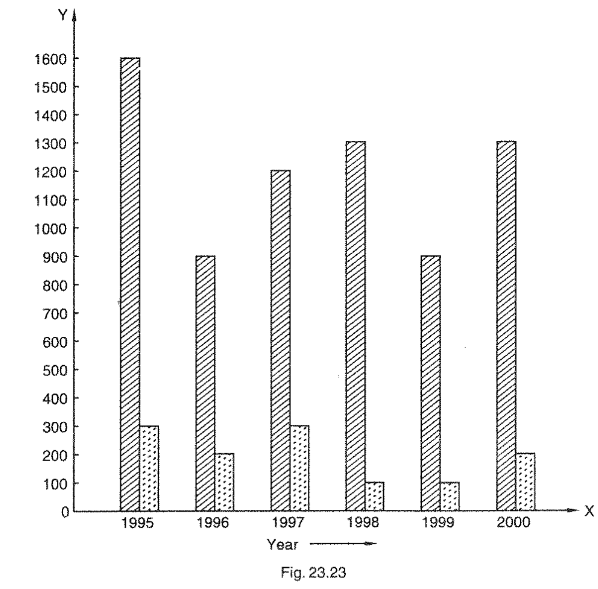 07:14View Solution
07:14View SolutionThe production of saleable steel in some of the steel plants of our country during 1999 is given below: Plant, Bhilai, Durgapur, Rourkela, Bokaro Production (in thousand tonnes), 160, 80, 200, 150 Construct a bar graph to represent the above data on a graph paper by using the scale 1 big divisions = 20 thousand and tonnes.
05:14View SolutionThe following data gives the number (in thousands) of applicants registered with an Employment Exchange during, 1995-2000: year, 1995, 1996, 1997, 1998, 1999, 2000 No. of application (Registered (in Thousand), 18, 20, 24, 28, 30, 34 Construct a bar graph to represent the above data.
03:20View SolutionThe following table gives the route length (in thousand kilometres) of the Indian Railways in some of the years: Year, 1960-61, 1970-71, 1980-81, 1990-91, 2000-2001 Route length (in thousand kilometres), 56, 60, 61, 74, 98 Represent the above data with the help of a bar graph.
03:54View SolutionThe following data gives the amount of loans (in crores of rupees) disbursed by a bank during some years: Year, 1992, 1993, 1994, 1995, 1996 Loan (in crores of rupees), 28, 33, 55, 55, 80 Represent the above data with the help of a bar graph. With the help of the bar graph, indicate the year in which amount of loan is not increased over that of the preceding year.
04:01View SolutionThe following table shows the interest paid by a company (in lakhs): Year, 1995-96, 1996-97, 1997-98, 1998-99, 1999-2000 Interest (in lakhs of rupees), 20, 25, 15, 18, 30 Draw the bar graph to represent the above information.
03:17View SolutionThe following data shows the average age of men in varicus countries in a certain year: Country, India, Nepal, China, Pakistan, U.K., U.S.A Average age (in years), 55, 52, 60, 50, 70, 75 Represent the above information by a bar graph.
04:03View SolutionThe following data gives the production of food grains (in thousand tonnes) for some years: Year 1995 1996 1997 1998 1999 2000 Production (in thousand tonnes) 120 150 140 180 170 190 Represent the above data with the help of a bar graph.
03:17View SolutionThe following data gives the amount of manure (in thousand tonnes) manufactured by a company during some years: Year, 1992, 1993, 1994, 1995, 1996, 1997 Manure (In thousand tonnes), 15, 35, 45, 30, 40, 20 Represent the above data with the help of a bar graph. Indicate with the help of the bar graph the year in which the amount of manure manufactured by the company was maximum. Choose the correct alternative: The consecutive years during which there was maximum decrease in manure production are: 1994 to 1995 (b) 1992 and 1993 1996-1997 (d) 1995 and 1996
05:04View Solution
All Questions questions and complete solutions for chapter DATA HANDLING-III (BAR GRAPHS) of RD SHARMA MATHS (HINGLISH) of Class 6
